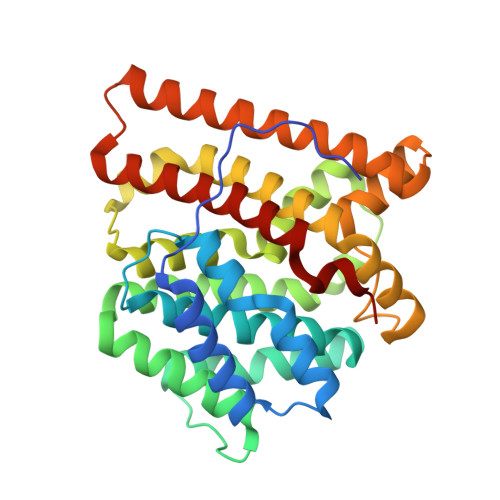Probing the Role of Active Site Water in the Sesquiterpene Cyclization Reaction Catalyzed by Aristolochene Synthase.
Chen, M., Chou, W.K., Al-Lami, N., Faraldos, J.A., Allemann, R.K., Cane, D.E., Christianson, D.W.(2016) Biochemistry 55: 2864-2874
- PubMed: 27172425
- DOI: https://doi.org/10.1021/acs.biochem.6b00343
- Primary Citation of Related Structures:
5IMI, 5IMN, 5IMP, 5IN8, 5IVG - PubMed Abstract:
Aristolochene synthase (ATAS) is a high-fidelity terpenoid cyclase that converts farnesyl diphosphate exclusively into the bicyclic hydrocarbon aristolochene. Previously determined crystal structures of ATAS complexes revealed trapped active site water molecules that could potentially interact with catalytic intermediates: water "w" hydrogen bonds with S303 and N299, water molecules "w1" and "w2" hydrogen bond with Q151, and a fourth water molecule coordinates to the Mg(2+)C ion. There is no obvious role for water in the ATAS mechanism because the enzyme exclusively generates a hydrocarbon product. Thus, these water molecules are tightly controlled so that they cannot react with carbocation intermediates. Steady-state kinetics and product distribution analyses of eight ATAS mutants designed to perturb interactions with active site water molecules (S303A, S303H, S303D, N299A, N299L, N299A/S303A, Q151H, and Q151E) indicate relatively modest effects on catalysis but significant effects on sesquiterpene product distributions. X-ray crystal structures of S303A, N299A, N299A/S303A, and Q151H mutants reveal minimal perturbation of active site solvent structure. Seven of the eight mutants generate farnesol and nerolidol, possibly resulting from addition of the Mg(2+)C-bound water molecule to the initially formed farnesyl cation, but no products are generated that would suggest enhanced reactivity of other active site water molecules. However, intermediate germacrene A tends to accumulate in these mutants. Thus, apart from the possible reactivity of Mg(2+)C-bound water, active site water molecules in ATAS are not directly involved in the chemistry of catalysis but instead contribute to the template that governs the conformation of the flexible substrate and carbocation intermediates.
Organizational Affiliation:
Roy and Diana Vagelos Laboratories, Department of Chemistry, University of Pennsylvania , Philadelphia, Pennsylvania 19104-6323, United States.


















